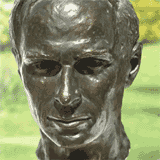
Gaia & Hania
John Roberts: John contacted me a few weeks before the end of my M. Phil. course at UCL. We worked together for four years, on a range of projects in such areas as environmental impact assessment and the role of ecologists in the planning system. A huge influence, not least in providing a model of an independent think tank and consultancy, of which TEST was one of the first.
Roger McGlynn: A colleague at TEST, Roger moved to Barnes - a visit to him in the summer of 1975 resulted in our decision to buy the house in the next street that we have lived in ever since.
Bernard Dixon: As editor of New Scientist, Bernard was a long-standing sponsor of my writing.
James Lovelock: I saw a piece he wrote in New Scientist in 1976 on his Gaia Hypothesis and decided if Elaine and I ever had a daughter, she would be Gaia. Gaia was born the following year. Many years later, on 22 March 1985, Elaine's idea of a time-capsule of seeds and books (including The Gaia Atlas of Planet Management) resulted in a capsule that you can still see in the Princess of Wales greenhouse at Kew Gardens. I later worked alongside him on the sustainability panel for the ill-fated Millennium Dome.
Gaia & Hania: I always said to Elaine that I wanted two daughters. When Hania arrived in 1979, Elaine said words to the effect of: "There you are, that's your lot!" Their influence is so pervasive it's hard to know where to start.

Gaia & Hania
Roger S. Payne: One of my favourite records during this period was Songs of the Humpback Whales (CRM Records, Dem Mar, California), recorded at sea through hydrophones by Dr Roger S. Payne. I used to turn the lights out and play the sounds of humpback and blue whales singing to Gaia and Hania late at night. It was like being immersed in a totally different realm, with these great creatures all around. Also had his album Deep Voices. As Payne said at the time, the world was "turning on to whales" - and he played a key role in the process.
Max Nicholson: Max asked me in 1978 to help set up Environmental Data Services (ENDS) with David Layton. I had read his book The Environmental Revolution: A Guide for the New Masters of the Earth (1970) years before meeting him. We worked together for 4-5 years directly, then continued to conspire over the years until his death in April 2003.
It turned out he had influenced me early on, when I was 11. I had asked all the boys at my prep school [see Major 'Ned' Adams] for their pocket money for two weeks for the just-formed the World Wildlife Fund (WWF: later the World Wide Fund for nature). Could never recall where that idea had come from. One day when we were driving down to WWF (which he co-founded) in the early 1980s, I told Max the story - and he said he had got four pages on WWF into a newspaper in 1961. Suddenly I remembered going into the school library and seeing the paper on a reading stand - that's where seeds were sown in the fertile ground Mother Superior had prepared.
So Max influenced me for more than 40 years. His obituary in The Times (30 April 2003) covered only a few of his extraordinary contributions. But one aspect it did touch on was telling: I remember being fascinated by his appointment during WWII as head of the Ministry of War Transport's allocation of tonnage division. Among other things, he oversaw the Pool of London at a time when Britain was being progressively starved by the U-boat campaign. His efforts then meant that he attended wartime summit meetings in Cairo, Quebec, Yalta and Potsdam. He told me that managing the complex dynamics involved in the Pool of London (including the interplay between ship arrivals, the tides and bombing raids) was much easier for an ecologist.
Max was born in 1904 and was 98 when he died. He and I were from very different wings of the environmental movement: he much more scientific, me more emotionally engaged, but we both agreed that ecological principles have to be fully integrated into our economies, a challenge that is no less urgent than when he and I first met. I wrote an obituary for Resurgence.
Max's memorial website is at www.maxnicholson.com
< previous people page
> next people page

Max Nicholson
Teddy Goldsmith: He and I ended up sharing a hotel bedroom for most of a week in Reykjavik during Nicholas Polunin's Second International Conference on the Environment Future. I had long admired Teddy's work with The Ecologist, although didn't always agree. Elaine, Gaia (aged around three weeks) and I stayed with him and his family in Cornwall while I did a New Scientist piece on English China Clays. Among others staying were Laurence D. and Hilda Cherry Hills, who founded the Henry Doubleday Research Association (HDRA).
Charles Medawar: A founder of Social Audit. I wrote of his work in New Scientist in 1978. In 1996 he became a founder-member of SustainAbility's Council.